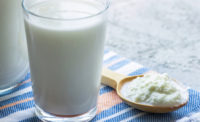The dairy industry has come a long way with-lactose-free products
There is an opportunity for dairy companies to continue sharing the progress we have made in the lactose-free dairy category and also to expand our story beyond milk.

Photo courtesy of Tatiana Atamaniuk / iStock / Getty Images Plus

It wasn’t long ago when consumers seeking lactose-free dairy products had limited options.
Today, these offerings are abundant with more than 98% of retail outlets providing lactose-free dairy milk and major brands producing private-label options. In fact, sales of lactose-free milk are a bright spot in the overall fluid milk category. Lactose-free milk retail volume sales are up 6.7% year to date (through Sept. 17), building on average annual growth of 10.2% from 2018 to 2022. Lactose-free milk holds 7.6% volume share of milk in 2023.
This increased access to lactose-free dairy foods is imperative when we talk about the necessity for dairy to remain an equitable option that can serve diverse needs. Equity is more than race, as it encompasses gender and socio-economic status, so dairy must be a category that remains culturally relevant, affordable and accessible.
The National Dairy Council led a study titled “Disparity in Dairy Servings Intake by Ethnicity and Age” that underscored the importance of continued expansion of dairy options that are culturally appropriate. The goal was to provide an update of current milk and dairy consumption across the lifespan and examine it more closely by race and ethnicity.
We already understood that total dairy consumption, especially milk consumption, decreases with age. Our research found differences in dairy consumption related to ethnicity, with Black, non-Hispanics and Asian children and adults consuming the least amount of dairy. Gaps were observed within and between ethnicities in total dairy and specific dairy product intakes across the lifespan.
But we also identified another important finding. The “other foods” category or mixed dishes (e.g., pizza, Mexican dishes, sandwiches, soups) make a significant contribution to dairy consumption and represents an important opportunity to help people meet their three daily dairy servings recommended by the Dietary Guidelines for Americans.
However, there remains a lack of consumer awareness about lactose-free and lower-lactose dairy foods as well as how to incorporate them into culturally appropriate mixed dishes. National Dairy Council recently presented at the Nutrition News Update conference attended by some of the leading national health journalists who anecdotally shared that people are unaware of available lactose-free dairy options. There also is low awareness that lactose-free dairy milk has the same 13 essential nutrients as regular milk, just without lactose.
This represents an opportunity for dairy companies to continue sharing the progress we've made in the lactose-free dairy category and also to expand our story beyond milk. Natural cheeses and Greek/Icelandic-style yogurts can offer more choices and an opportunity to close the gap on daily dairy consumption to benefit health.
The dairy sector has come a long way to offer products that meet multicultural needs and sharing that these options are available is an important step in helping more people embrace dairy foods. It’s exciting to know more opportunities exist for dairy to meet diverse consumer needs while increasing nutritional needs.
Looking for a reprint of this article?
From high-res PDFs to custom plaques, order your copy today!







